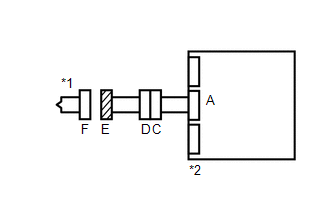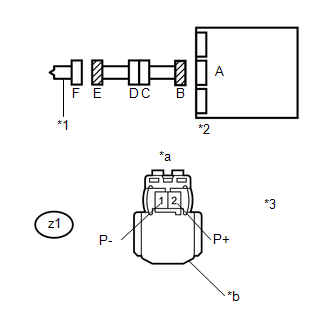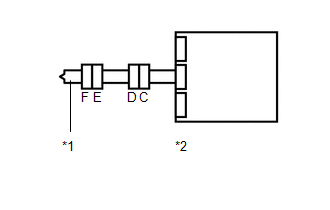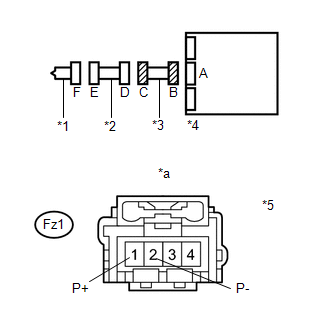Toyota 4Runner: Short in Front Passenger Side Squib Circuit (B1805/52-B1808/52)
DESCRIPTION
The front passenger side squib circuit consists of the center airbag sensor and instrument panel passenger airbag.
The circuit instructs the SRS to deploy when deployment conditions are met.
These DTCs are stored when a malfunction is detected in the front passenger side squib circuit.
|
DTC Code |
DTC Detection Condition |
Trouble Area |
|---|---|---|
|
B1805/52 |
One of the following conditions is met:
|
|
|
B1806/52 |
One of the following conditions is met:
|
|
|
B1807/52 |
One of the following conditions is met:
|
|
|
B1808/52 |
One of the following conditions is met:
|
|
WIRING DIAGRAM
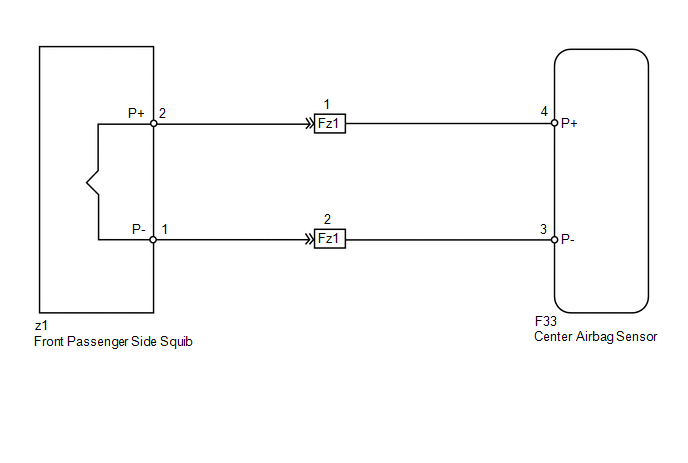
CAUTION / NOTICE / HINT
NOTICE:
When disconnecting the cable from the negative (-) battery terminal while performing
repairs, some systems need to be initialized after the cable is reconnected (See
page .gif) ).
).
HINT:
To perform the simulation method, enter check mode (signal check) with the Techstream
(See page .gif) ), and then wiggle each connector of
), and then wiggle each connector of
the airbag system or drive the vehicle on various types of road (See page
.gif) ).
).
PROCEDURE
|
1. |
CHECK INSTRUMENT PANEL PASSENGER AIRBAG ASSEMBLY (FRONT PASSENGER SIDE SQUIB) |
|
(a) Turn the ignition switch off. |
|
(b) Disconnect the cable from the negative (-) battery terminal, and wait for at least 90 seconds.
(c) Disconnect the connectors from the instrument panel passenger airbag.
(d) Connect the white wire side of SST (resistance: 2.1 Ω) to connector E (orange connector).
CAUTION:
Never connect the tester to the instrument panel passenger airbag (front passenger side squib) for measurement, as this may lead to a serious injury due to airbag deployment.
NOTICE:
- Do not forcibly insert SST into the terminals of the connector when connecting SST.
- Insert SST straight into the terminals of the connector.
SST: 09843-18061
(e) Connect the cable to the negative (-) battery terminal, and wait for at least 2 seconds.
(f) Turn the ignition switch to ON, and wait for at least 60 seconds.
(g) Clear the DTCs (See page .gif) ).
).
(h) Turn the ignition switch off.
(i) Turn the ignition switch to ON, and wait for at least 60 seconds.
(j) Check for DTCs (See page .gif) ).
).
OK:
DTC B1805, B1806, B1807 or B1808 is not output.
HINT:
Codes other than DTC B1805, B1806, B1807 and B1808 may be output at this time, but they are not related to this check.
Text in Illustration|
*1 |
Front Passenger Side Squib |
|
*2 |
Center Airbag Sensor |
|
*3 |
Connector E |
|
*4 |
SST |
|
*a |
Front view of wire harness connector (to Front Passenger Side Squib) |
|
*b |
Color: Orange |
| OK | .gif) |
REPLACE INSTRUMENT PANEL PASSENGER AIRBAG ASSEMBLY |
|
|
2. |
CHECK CONNECTOR |
(a) Turn the ignition switch off.
(b) Disconnect the cable from the negative (-) battery terminal, and wait for at least 90 seconds.
(c) Disconnect SST from connector E.
|
(d) Check that the No. 2 instrument panel wire connectors (on the instrument panel passenger airbag side) are not damaged. OK: The lock button is not disengaged, and the claw of the lock is not deformed or damaged. Text in Illustration
|
|
| NG | .gif) |
REPLACE NO. 2 INSTRUMENT PANEL WIRE |
|
|
3. |
CHECK FRONT PASSENGER SIDE SQUIB CIRCUIT |
|
(a) Disconnect the connectors from the center airbag sensor. |
|
(b) Connect the cable to the negative (-) battery terminal, and wait for at least 2 seconds.
(c) Measure the voltage according to the value(s) in the table below.
Standard Voltage:
|
Tester Connection |
Switch Condition |
Specified Condition |
|---|---|---|
|
F1-2 (P+) - Body ground |
Ignition switch ON |
Below 1 V |
|
F1-1 (P-) - Body ground |
Ignition switch ON |
Below 1 V |
(d) Turn the ignition switch off.
(e) Disconnect the cable from the negative (-) battery terminal, and wait for at least 90 seconds.
(f) Measure the resistance according to the value(s) in the table below.
Standard Resistance:
|
Tester Connection |
Condition |
Specified Condition |
|---|---|---|
|
F1-2 (P+) - F1-1 (P-) |
Always |
Below 1 Ω |
(g) Release the activation prevention mechanism built into connector B (See page
.gif) ).
).
(h) Measure the resistance according to the value(s) in the table below.
Standard Resistance:
|
Tester Connection |
Condition |
Specified Condition |
|---|---|---|
|
F1-2 (P+) - F1-1 (P-) |
Always |
1 MΩ or higher |
|
F1-2 (P+) - Body ground |
Always |
1 MΩ or higher |
|
F1-1 (P-) - Body ground |
Always |
1 MΩ or higher |
|
*1 |
Front Passenger Side Squib |
|
*2 |
Center Airbag Sensor |
|
*3 |
Connector E |
|
*a |
Front view of wire harness connector (to Front Passenger Side Squib) |
|
*b |
Color: Orange |
| NG | .gif) |
GO TO STEP 5 |
|
|
4. |
CHECK CENTER AIRBAG SENSOR |
|
(a) Connect the connectors to the instrument panel passenger airbag and center airbag sensor. |
|
(b) Connect the cable to the negative (-) battery terminal, and wait for at least 2 seconds.
(c) Turn the ignition switch to ON, and wait for at least 60 seconds.
(d) Clear the DTCs (See page .gif) ).
).
(e) Turn the ignition switch off.
(f) Turn the ignition switch to ON, and wait for at least 60 seconds.
(g) Check for DTCs (See page .gif) ).
).
OK:
DTC B1805, B1806, B1807 or B1808 is not output.
HINT:
Codes other than DTC B1805, B1806, B1807 and B1808 may be output at this time, but they are not related to this check.
Text in Illustration|
*1 |
Front Passenger Side Squib |
|
*2 |
Center Airbag Sensor |
| OK | .gif) |
USE SIMULATION METHOD TO CHECK |
| NG | .gif) |
REPLACE CENTER AIRBAG SENSOR ASSEMBLY |
|
5. |
CHECK INSTRUMENT PANEL WIRE (CENTER AIRBAG SENSOR - NO. 2 INSTRUMENT PANEL WIRE) |
|
(a) Restore the released activation prevention mechanism of connector B to its original condition. |
|
(b) Disconnect the instrument panel wire connector from the No. 2 instrument panel wire.
(c) Connect the cable to the negative (-) battery terminal, and wait for at least 2 seconds.
(d) Measure the voltage according to the value(s) in the table below.
Standard Voltage:
|
Tester Connection |
Switch Condition |
Specified Condition |
|---|---|---|
|
Fz1-1 (P+) - Body ground |
Ignition switch ON |
Below 1 V |
|
Fz1-2 (P-) - Body ground |
Ignition switch ON |
Below 1 V |
(e) Turn the ignition switch off.
(f) Disconnect the cable from the negative (-) battery terminal, and wait for at least 90 seconds.
(g) Measure the resistance according to the value(s) in the table below.
Standard Resistance:
|
Tester Connection |
Condition |
Specified Condition |
|---|---|---|
|
Fz1-1 (P+) - Fz1-2 (P-) |
Always |
Below 1 Ω |
(h) Release the activation prevention mechanism built into connector B (See page
.gif) ).
).
(i) Measure the resistance according to the value(s) in the table below.
Standard Resistance:
|
Tester Connection |
Condition |
Specified Condition |
|---|---|---|
|
Fz1-1 (P+) - Fz1-2 (P-) |
Always |
1 MΩ or higher |
|
Fz1-1 (P+) - Body ground |
Always |
1 MΩ or higher |
|
Fz1-2 (P-) - Body ground |
Always |
1 MΩ or higher |
|
*1 |
Front Passenger Side Squib |
|
*2 |
No. 2 Instrument Panel Wire |
|
*3 |
Instrument Panel Wire |
|
*4 |
Center Airbag Sensor |
|
*5 |
Connector C |
|
*a |
Front view of wire harness connector (to No. 2 Instrument Panel Wire) |
| OK | .gif) |
REPLACE NO. 2 INSTRUMENT PANEL WIRE |
| NG | .gif) |
REPLACE INSTRUMENT PANEL WIRE |
 Short in Driver Side Squib Circuit (B1800/51-B1803/51)
Short in Driver Side Squib Circuit (B1800/51-B1803/51)
DESCRIPTION
The driver side squib circuit consists of the center airbag sensor,
spiral cable and steering pad.
The circuit instructs the SRS to deploy when deployment conditions are
...
 Short in Driver Side Squib 2nd Step Circuit (B1810/53-B1813/53)
Short in Driver Side Squib 2nd Step Circuit (B1810/53-B1813/53)
DESCRIPTION
The driver side squib 2nd step circuit consists of the center airbag sensor,
spiral cable and steering pad.
The circuit instructs the SRS to deploy when deployment conditions are met.
...
Other materials about Toyota 4Runner:
Adjustment
ADJUSTMENT
PROCEDURE
1. STEERING OFF CENTER ADJUSTMENT PROCEDURE
HINT:
This is the adjustment procedure for when the steering is off center.
(a) Check if the steering wheel is off center.
(1) Apply masking tape to the top center of the steerin ...
Changing the registered name of a portable player
Select “Change Name” using a
voice command or .
Select the name of the portable
player to be changed by either of the following methods, and select “Confirm”
using a voice command or :
a. Press the talk switch and say the name of desired port ...
0.0083

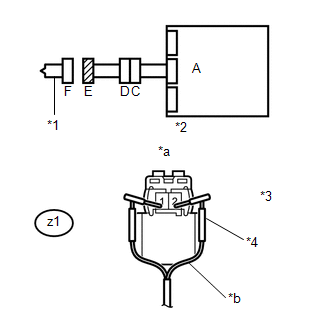
.gif)
